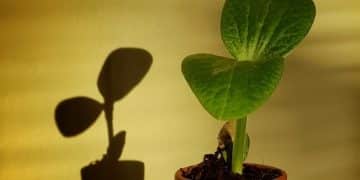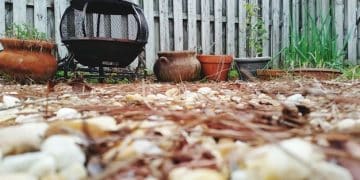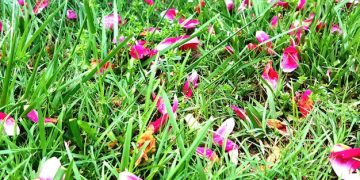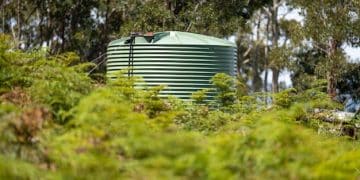Eco-Friendly Landscaping: Sustainable Yards With Native Plants
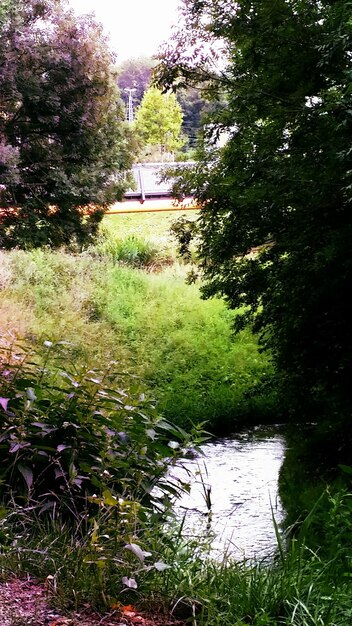
Achieving an eco-friendly landscape involves incorporating native plants, which not only flourish naturally with minimal intervention but also enhance biodiversity, conserve water, and significantly reduce maintenance needs, contributing to a truly sustainable yard.
Transforming your outdoor space into an eco-friendly sanctuary is more than just a trend; it’s a commitment to sustainability. Eco-Friendly Landscaping: Create a Beautiful and Sustainable Yard with Native Plants offers a pathway to a vibrant, low-maintenance garden that thrives in harmony with nature. Discover how native flora can revolutionize your approach to gardening, fostering a rich ecosystem right in your backyard.
The Foundations of Eco-Friendly Landscaping
Eco-friendly landscaping, often referred to as sustainable landscaping, focuses on designing, building, and maintaining gardens and outdoor spaces in a way that minimizes environmental impact and conserves natural resources. This approach goes beyond aesthetics, aiming to create a balanced ecosystem that benefits both humans and wildlife. It emphasizes long-term sustainability rather than short-term visual appeal that might come at a high ecological cost.
Understanding the core principles is crucial. These include water conservation, reduced energy consumption, waste reduction, and the promotion of biodiversity. Each element plays a vital role in creating a landscape that is resilient, beautiful, and contributes positively to the local environment.
Water Conservation Techniques
Water is a precious resource, and eco-friendly landscaping prioritizes its efficient use. This means choosing plants that require less water, especially those native to your region, and implementing smart irrigation systems. Smart technology can monitor weather patterns and soil moisture, delivering water only when and where it’s needed, thus preventing waste.
- 💧 Xeriscaping Principles: Design landscapes to reduce or eliminate the need for irrigation. This involves grouping plants with similar water needs and using drought-tolerant species.
- ☔ Rainwater Harvesting: Collect rainwater from roofs or other surfaces in rain barrels or cisterns for later use in irrigation. This provides a free, natural water source.
- 🌱 Drip Irrigation: Install drip irrigation systems that deliver water directly to the plant roots, minimizing evaporation and runoff compared to traditional sprinklers.
By adopting these water-saving measures, you can dramatically cut down on your water bills and reduce your environmental footprint. It also helps in maintaining the health of local watersheds.
Energy Efficiency in Landscape Design
A well-designed eco-friendly landscape can significantly reduce your home’s energy consumption. Strategic placement of trees and shrubs can provide natural shading in summer, cutting cooling costs, and act as windbreaks in winter, lowering heating expenses. This passive energy design integrates your home with its surroundings for optimal climate control.
Considering local climate and sun exposure during the design phase ensures that these natural elements work harmoniously with your home. Deciduous trees, for instance, offer shade in summer when they have leaves and allow sunlight to warm your home in winter after their leaves fall.
Ultimately, eco-friendly landscaping is about creating a symbiotic relationship between your garden, your home, and the broader environment. It’s a holistic approach that delivers both aesthetic beauty and practical benefits, fostering a healthier planet.
The Power of Native Plants in Sustainable Gardening
Native plants are the cornerstone of any truly eco-friendly landscape. These species have evolved over thousands of years within specific regions, developing an innate resilience and adaptation to local climate, soil conditions, and rainfall patterns. Their introduction into suburban gardens dramatically reduces the need for external inputs like excessive water, fertilizers, and pesticides, making them an unparalleled choice for sustainable gardening.
Choosing native plants is a strategic decision that goes beyond ease of maintenance; it’s an act of ecological restoration that supports the delicate balance of local ecosystems. They are perfectly attuned to their environment, requiring less intervention to thrive, which translates into less work and lower costs for the homeowner.
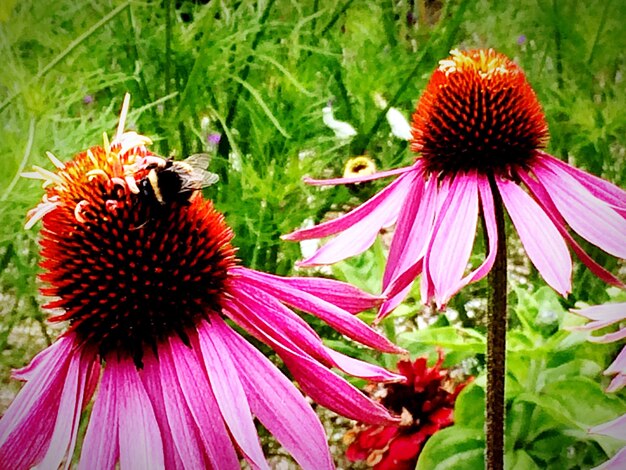
Biodiversity Boosters: Why Native Plants Matter
One of the most significant benefits of native plants is their role in fostering biodiversity. They provide essential food, shelter, and breeding grounds for local wildlife, including pollinators like bees and butterflies, as well as birds and small mammals. Non-native ornamental plants, while often beautiful, rarely offer the same ecological value, often leaving local fauna without the resources they rely on.
- 🦋 Pollinator Support: Native flowers are perfectly synchronized with native pollinators, whose survival often depends on specific plant species. For example, monarch butterflies rely exclusively on milkweed for their caterpillars.
- 🐦 Bird Habitats: Many native plants produce seeds, berries, and nectar that are vital food sources for local bird populations throughout the year. They also offer ideal nesting sites and protective cover.
- 🐛 Insect Resilience: Native plants host a variety of insects, which in turn form the base of the food web for birds and other wildlife, ensuring a stable ecological system within your yard.
By planting native species, you are not just creating a garden; you are establishing a vital link in the local food web, contributing to the health and resilience of your community’s natural heritage.
Low Maintenance, High Reward
The adaptability of native plants makes them incredibly low-maintenance once established. They don’t require the constant watering, fertilizing, or pest control often associated with non-native species. This liberation from endless garden chores allows homeowners to enjoy their outdoor spaces more, proving that environmental responsibility can also be incredibly convenient.
Their inherent resistance to local pests and diseases means less reliance on chemical treatments, further reducing the environmental impact of your garden. Furthermore, their deep root systems can help prevent soil erosion and improve soil health, naturally enhancing the landscape’s ability to retain moisture and nutrients. This translates to a healthier yard with minimal effort, allowing you to spend less time on upkeep and more time enjoying the beauty of your sustainable garden.
Designing Your Eco-Friendly Landscape
Designing an eco-friendly landscape is a thoughtful process that considers both aesthetics and ecological function. It involves integrating various elements to create a harmonious and sustainable outdoor space. This deliberate planning minimizes waste, conserves resources, and enhances the natural beauty of your property.
The initial steps involve understanding your site’s specific conditions, including sun exposure, soil type, and existing flora and fauna. This foundational knowledge allows for informed decisions regarding plant selection and landscape layout, ensuring long-term success and minimal intervention.
Site Analysis and Planning
Before putting shovel to soil, a thorough site analysis is crucial. Evaluate your property’s microclimates, where sunlight hits at different times of the day, and soil composition, as these factors dictate which native plants will thrive. Observe existing drainage patterns and consider how you can redirect rainwater to benefit your landscape rather than cause erosion.
Mapping out “zones” with varying sun exposure (full sun, partial shade, full shade) will guide your plant selection. Similarly, understanding your soil’s pH and nutrient levels will inform whether you need to amend it, though native plants often adapt well to existing conditions.
Consider the desired functions of different areas, such as entertaining spaces, relaxation spots, or vegetable gardens. Integrating these human-centric needs with ecological principles ensures a landscape that is both functional and environmentally sound. Thoughtful planning reduces future maintenance and resource consumption. This initial investment in time pays significant dividends in the long run.
Choosing the Right Native Plants
Selecting the right native plants is perhaps the most exciting part of designing an eco-friendly landscape. Research plants that are indigenous to your specific region, as these will be best adapted to your local climate and soil conditions. Local nurseries or native plant societies are excellent resources for identifying appropriate species.
- 🌻 Regional Adaptation: Prioritize plants explicitly native to your geographical area, not just your state. For example, a plant native to Florida won’t necessarily thrive in the colder climate of Vermont.
- 🎨 Diverse Selection: Choose a variety of native plants—trees, shrubs, perennials, and groundcovers—to create year-round interest and provide diverse habitats for wildlife. Include plants with different bloom times to ensure continuous pollen and nectar sources.
- 🌿 Growth Habits & Size: Understand the mature size and growth habits of the plants you select. Avoid overcrowding and ensure plants have ample space to grow without requiring excessive pruning.
Consider texture, color, and height to create visual interest. Aim for a multi-layered landscape that mimics natural ecosystems, providing varied habitats. This careful selection ensures your plants will flourish with minimal intervention, reflecting the beauty of your local environment.
Implementing Sustainable Practices in Your Yard
Beyond plant selection, implementing sustainable practices is essential for establishing and maintaining an eco-friendly landscape. These practices focus on minimizing the use of external resources, reducing waste, and promoting natural cycles within your garden. They transform a conventional yard into a self-sustaining ecosystem.
This holistic approach encompasses everything from soil management to pest control, ensuring that every aspect of your garden contributes positively to the environment. It’s about working with nature, not against it, to create a healthier, more resilient outdoor space.
Soil Health and Composing
Healthy soil is the foundation of a thriving eco-friendly garden. Instead of relying on synthetic fertilizers, which can harm beneficial microorganisms and leach into waterways, focus on enriching your soil naturally. Composting is an excellent way to turn kitchen scraps and yard waste into nutrient-rich soil amendments.
Adding organic matter to your soil improves its structure, enhances water retention, and provides a slow-release source of nutrients for plants. This also encourages beneficial soil organisms like earthworms, which are vital for soil aeration and nutrient cycling. Regular soil testing can help you understand its composition and guide your composting and amendment strategies.
Mulching is another critical practice for soil health. A layer of organic mulch helps retain soil moisture, suppress weeds, and regulate soil temperature. As mulch breaks down, it adds valuable organic matter to the soil, further enhancing its fertility and structure over time. These practices create a robust foundation for plant growth.
Natural Pest and Disease Management
Eco-friendly landscaping avoids synthetic pesticides and herbicides, which can harm beneficial insects, pets, and even humans, as well as polluting water sources. Instead, it relies on natural pest and disease management strategies that promote a balanced ecosystem where natural predators keep pests in check.
- 🐞 Encourage Beneficial Insects: Plant flowers that attract ladybugs, lacewings, and other predatory insects. These natural pest controllers can significantly reduce pest populations.
- 👩🌾 Companion Planting: Strategically plant certain species together to deter pests. For instance, marigolds can repel nematodes, while strong-smelling herbs like basil can deter flies.
- 🌿 Regular Monitoring & Manual Removal: Routinely inspect your plants for signs of pests or disease. Early detection allows for manual removal or targeted, natural treatments before problems escalate.
Promoting plant health through proper watering, air circulation, and nutrient-rich soil also makes plants more resistant to pests and diseases. A diverse garden with a variety of plant species is naturally more robust and less susceptible to widespread infestations.
Water Conservation and Waste Reduction in Landscaping
Water conservation and waste reduction are two pillars of eco-friendly landscaping. By implementing smart irrigation techniques and minimizing garden waste, you can significantly reduce your environmental impact and create a more sustainable outdoor space. These practices not only benefit the planet but also reduce maintenance and costs over time.
The goal is to create a closed-loop system where resources are reused and conserved, moving away from a linear model of consumption and disposal. This proactive approach ensures your landscape is both resource-efficient and environmentally responsible.
Efficient Irrigation Systems
Traditional sprinkler systems often waste a significant amount of water through evaporation, runoff, and overspray. Eco-friendly landscaping prioritizes efficient irrigation methods that deliver water precisely where it’s needed, directly to the plant roots.
Drip irrigation systems are an excellent choice for targeted watering, minimizing water loss due to evaporation. Soaker hoses, another efficient option, slowly release water along their length, ensuring deep saturation without runoff. Both systems are ideal for garden beds, trees, and shrubs, providing maximum water efficiency.
Smart irrigation controllers with rain sensors or soil moisture probes can further enhance efficiency. These devices automatically adjust watering schedules based on real-time weather conditions and soil moisture levels, preventing overwatering and ensuring plants receive just the right amount of water. This precision helps conserve water while keeping plants healthy.
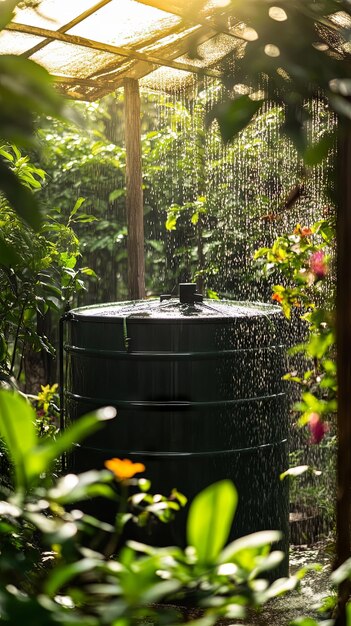
Composting and Mulching for a Circular Garden
Waste reduction in the garden extends beyond just avoiding chemicals. It encompasses managing organic waste responsibly, primarily through composting and mulching. Instead of sending yard waste to landfills, where it produces harmful methane gas, transform it into valuable resources for your garden.
- ♻️ Home Composting: Create a compost pile or use a compost bin for kitchen scraps (fruit and vegetable peels, coffee grounds) and yard waste (leaves, grass clippings). This rich, dark soil amendment improves soil structure and fertility.
- 🍃 Leaf Mulching: Instead of raking and bagging leaves, chop them with a mower and leave them on your lawn or garden beds. They act as a natural mulch, returning nutrients to the soil and suppressing weeds.
- 🪵 Garden Waste Reuse: Use larger branches and woody debris as pathways or borders, or chip them for mulch. Reusing green waste within your garden reduces the need for external resources and transport.
These practices create a circular system where nutrients are recycled back into the soil, reducing the need for synthetic fertilizers and improving overall soil health. Embracing composting and mulching helps you create a truly sustainable and self-sufficient garden that mimics nature’s own cycles.
Long-Term Benefits and Enjoyment of Your Eco-Friendly Yard
The journey to an eco-friendly landscape is an investment that yields significant long-term benefits, extending far beyond the initial effort. These advantages impact your personal well-being, financial savings, and the broader environmental health of your community. Creating a sustainable yard is a commitment to a healthier planet and a more fulfilling lifestyle.
From reducing water bills to fostering local wildlife, an eco-friendly landscape offers a multitude of returns. It transforms your outdoor space into a sanctuary that enhances both your quality of life and the ecological resilience of your surroundings.
Cost Savings and Increased Property Value
One of the most immediate and tangible benefits of eco-friendly landscaping is the significant cost savings it provides. Native plants, requiring less water, fertilizer, and pest control, drastically reduce ongoing maintenance expenses. Water bills plummet with efficient irrigation systems and drought-tolerant planting. The lack of chemical inputs means no more purchasing expensive pesticides or herbicides.
Beyond recurring savings, a well-designed eco-friendly landscape can enhance your property value. Buyers are increasingly seeking homes with sustainable outdoor spaces that offer beauty, low maintenance, and environmental benefits. A thoughtfully planned native plant garden can be a unique selling point, setting your home apart in the market and reflecting a growing public awareness of ecological responsibility.
The reduction in maintenance time is another invaluable saving. With native plants thriving independently, you’ll spend less time on tedious tasks like weeding, watering, and fertilizing, freeing up more time to simply enjoy your beautiful, thriving yard.
Enhanced Biodiversity and Community Impact
By transforming your yard into an eco-friendly haven, you contribute directly to the enhancement of local biodiversity. Your garden becomes a vital sanctuary for native wildlife, from pollinators to birds and beneficial insects, helping to counteract habitat loss and support delicate ecosystems.
This ripple effect extends beyond your property line. When neighbors adopt similar practices, a network of green corridors can emerge, providing continuous habitat for wildlife and contributing to regional ecological health. Your eco-friendly yard becomes a small but significant piece of a larger conservation effort, demonstrating how individual actions can collectively make a substantial difference.
Moreover, participating in eco-friendly landscaping often connects you with a community of like-minded individuals. Sharing knowledge, resources, and successes fosters a collective movement towards more sustainable living. This shared purpose strengthens community bonds and amplifies the positive environmental impact, creating a sense of collective responsibility and achievement.
Overcoming Challenges and Common Myths
Transitioning to eco-friendly landscaping can present a few challenges, and it’s important to address common myths that might deter enthusiasts. Understanding these hurdles and debunking misconceptions is crucial for a successful and realistic approach to sustainable gardening. With proper planning and accurate information, these perceived obstacles can be easily overcome.
Many concerns revolve around the aesthetics of native plants or the perceived difficulty of designing an eco-friendly space. However, dispelling these myths reveals a world of aesthetic possibilities and practical solutions, making sustainable landscaping accessible to everyone.
Addressing Aesthetic Concerns
One common misconception is that eco-friendly landscapes, particularly those dominated by native plants, lack aesthetic appeal or appear “wild” and unkempt. This couldn’t be further from the truth. Native plants come in an incredible diversity of shapes, sizes, colors, and textures, offering endless design possibilities that can be as formal or informal as desired.
- 🌸 Structured Wildness: Combine native plants with hardscaping elements like pathways, retaining walls, or decorative rocks to create structured beauty. This blend allows for a natural feel while maintaining a manicured look.
- ✂️ Strategic Pruning: Regular, strategic pruning can keep native plants tidy and encourage desired growth habits, preventing them from looking overgrown. This light maintenance ensures a neat appearance without compromising ecological benefits.
- 🎨 Purposeful Grouping: Group plants with similar growth habits and complementary colors to create visually appealing arrangements. Thoughtful grouping enhances visual flow and provides clear design intention.
The beauty of native plant gardens often lies in their natural resilience and the vibrant life they attract. They offer an ever-changing display of seasonal interest, creating a dynamic and engaging landscape that evolves beautifully throughout the year. With a bit of design intention, an eco-friendly yard can be just as stunning, if not more so, than a traditional one.
Navigating Initial Setup and Resources
Another challenge can be the initial setup. While eco-friendly landscapes are low-maintenance in the long run, the transition phase can require some effort. This includes amending soil, removing invasive species, and establishing new plant communities. However, numerous resources are available to simplify this process.
Local native plant nurseries or conservation organizations often provide valuable guidance on plant selection, design principles, and best practices for your specific region. Many offer workshops or online resources to help homeowners get started. Garden clubs and online forums can also be excellent sources of peer support and practical advice.
It’s important to view the initial investment of time and effort as laying the groundwork for a truly sustainable and enjoyable outdoor space. The rewards, in terms of reduced maintenance, lower costs, and enhanced environmental benefits, far outweigh the initial commitment. Embracing an eco-friendly landscape is a journey, and with the right resources, it’s a rewarding one.
| Key Aspect | Brief Description |
|---|---|
| 🌿 Native Plants | Naturally adapted species requiring minimal water and upkeep, supporting local biodiversity. |
| 💧 Water Conservation | Techniques like xeriscaping, rainwater harvesting, and drip irrigation to save water. |
| ♻️ Waste Reduction | Composting and mulching organic matter to enrich soil and minimize landfill waste. |
| 💰 Cost Savings | Lower utility bills and reduced maintenance costs due to efficient, resilient planting. |
Frequently Asked Questions About Eco-Friendly Landscaping
▼
Eco-friendly landscaping offers numerous benefits, including significant water conservation, reduced need for chemical fertilizers and pesticides, lower energy consumption due to strategic planting, and enhanced biodiversity by providing habitat for native wildlife. It also typically results in lower maintenance costs and contributes to a healthier local ecosystem.
▼
Native plants are crucial because they are inherently adapted to local climate and soil conditions, requiring less water, fertilizer, and pest control. They support native pollinators and wildlife, fostering biodiversity and strengthening the local food web. Their resilience makes them low-maintenance, reducing the effort and resources needed to maintain a healthy garden.
▼
Water conservation is key to eco-friendly landscaping. Strategies include adopting xeriscaping principles by choosing drought-tolerant native plants, implementing drip irrigation systems, and collecting rainwater through rain barrels. Smart irrigation controllers that adjust based on weather and soil moisture also significantly reduce water waste, ensuring efficient hydration.
▼
While the initial setup costs for an eco-friendly landscape might be comparable to traditional landscaping, the long-term savings are substantial. Native plants require fewer inputs like water, fertilizers, and pesticides, leading to significantly lower maintenance costs. The reduced need for resources typically results in a faster return on investment and ongoing savings.
▼
Begin by assessing your property’s specific conditions, including sun exposure and soil type. Research native plants suitable for your region, then plan your garden zones to group plants with similar needs. Start small with a dedicated bed, gradually expanding as you gain confidence. Consult local nurseries or native plant societies for tailored advice and resources.
Conclusion
Ultimately, embracing eco-friendly landscaping with native plants is not merely about enhancing your yard’s beauty; it’s about fostering a sustainable relationship with the environment. By choosing species adapted to your local climate, conserving water, enhancing soil health, and reducing waste, you create a vibrant, resilient ecosystem that benefits both nature and your household. This approach reduces maintenance efforts, lowers costs, and significantly contributes to local biodiversity, proving that a beautiful garden can truly go hand-in-hand with ecological responsibility.
